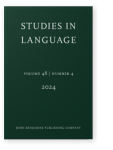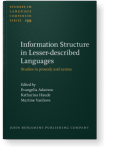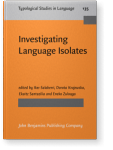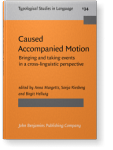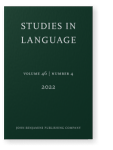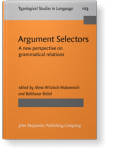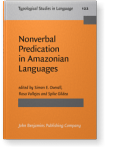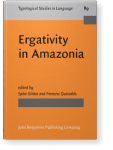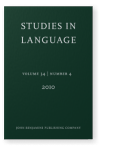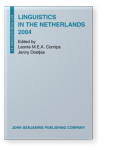Katharina Haude
List of John Benjamins publications for which Katharina Haude plays a role.
Journal
Titles
Information Structure in Lesser-described Languages: Studies in prosody and syntax
Edited by Evangelia Adamou, Katharina Haude and Martine Vanhove
[Studies in Language Companion Series, 199] 2018. vi, 450 pp.
Subjects Phonology | Syntax | Theoretical linguistics
Subordination in Native South American Languages
Edited by Rik van Gijn, Katharina Haude and Pieter Muysken
[Typological Studies in Language, 97] 2011. viii, 315 pp.
Subjects Languages of South America | Syntax | Theoretical linguistics | Typology
2025 An Austronesian-type voice system in an Amazonian isolate? Comparing Movima and Tagalog Investigating Language Isolates: Typological and diachronic perspectives, Salaberri, Iker, Dorota Krajewska, Ekaitz Santazilia and Eneko Zuloaga (eds.), pp. 71–102 | Chapter
The paper discusses some typologically rare structural similarities between Movima, a South American isolate, and the Austronesian language Tagalog. Both languages have a symmetrical voice system, and in both languages verbs and nouns are to some degree syntactically equivalent. For Tagalog, it… read more
2022 Expressing directional caused accompanied motion in Movima Caused Accompanied Motion: Bringing and taking events in a cross-linguistic perspective, Margetts, Anna, Sonja Riesberg and Birgit Hellwig (eds.), pp. 77–99 | Chapter
In Movima (isolate, Bolivia), caused accompanied motion is typically expressed with two verbs: jiwa-ɬe ‘bring’ and joy-ɬe ‘take’. They are composed of a root denoting directional motion (jiwa-‘come’ and joy‑ ‘go’) and an applicative suffix expressing causation and accompaniment (-ɬe). The core… read more
2022 Cross-linguistic patterns in the lexicalisation of bring and take Studies in Language 46:4, pp. 934–993 | Article
This study investigates the linguistic expression of bring and take events and more generally of the semantic domain of directed caused accompanied motion (‘directed CAM’) across a sample of eight languages of the Pacific and the Americas. Unlike English, the majority of languages in our sample… read more
2019 Grammatical relations in Movima: Alignment beyond semantic roles Argument Selectors: A new perspective on grammatical relations, Witzlack-Makarevich, Alena and Balthasar Bickel (eds.), pp. 213–256 | Chapter
Movima (isolate, Bolivia) has two transitive constructions: direct/ergative and inverse/accusative. The most straightforward argument selector is relativization. Relativization selects the P of the direct and the A of the inverse construction, which, in each case, is the argument whose referent… read more
2018 Chapter 1. Investigating information structure in lesser-known and endangered languages: An introduction Information Structure in Lesser-described Languages: Studies in prosody and syntax, Adamou, Evangelia, Katharina Haude and Martine Vanhove (eds.), pp. 1–13 | Chapter
2018 Chapter 8. A topic-marking cleft? Analyzing clause-initial pronouns in Movima Information Structure in Lesser-described Languages: Studies in prosody and syntax, Adamou, Evangelia, Katharina Haude and Martine Vanhove (eds.), pp. 217–244 | Chapter
While basic clauses in Movima are predicate-initial, one construction contains an initial free pronoun. Syntactic tests show that this “pronominal construction”, rather than resulting from a word-order change, is syntactically complex: The pronoun serves as the predicate and the verb behaves like a… read more
2018 Chapter 8. Nonverbal predication in Movima Nonverbal Predication in Amazonian Languages, Overall, Simon E., Rosa Vallejos and Spike Gildea (eds.), pp. 217–244 | Chapter
Movima (isolate, lowland Bolivia) is a language with predicate-initial constituent order in the core clause. There is no copula in affirmative clauses. Unpossessed common nouns can function as main-clause predicates just as well as verbs. The difference between verbal and nonverbal predicates only… read more
2011 Subordination in South America: An overview Subordination in Native South American Languages, Gijn, Rik van, Katharina Haude and Pieter Muysken (eds.), pp. 1–24 | Article
2011 Referring to states and events: Subordination in Movima Subordination in Native South American Languages, Gijn, Rik van, Katharina Haude and Pieter Muysken (eds.), pp. 141–168 | Article
2010 The intransitive basis of Movima clause structure Ergativity in Amazonia, Gildea, Spike and Francesc Queixalós (eds.), pp. 285–316 | Article
In Movima (unclassified, lowland Bolivia), the arguments of a transitive clause are basically encoded according to the position of their referents in a salience hierarchy, which includes deictic, semantic, and pragmatic levels. The participant roles of the arguments (actor or undergoer) are… read more
2010 Review of Guillaume (2008): A grammar of Cavineña Studies in Language 34:4, pp. 913–921 | Review
2007 Review of Garay (2004): Diccionario Tehuelche-Español/Indice Español-Tehuelche Studies in Language 31:3, pp. 683–690 | Review
2004 Nominal tense marking in Movima: Nominal or clausal scope? Linguistics in the Netherlands 2004, Cornips, Leonie and Jenny Doetjes (eds.), pp. 80–90 | Article
